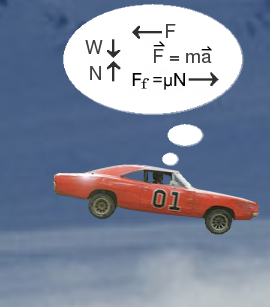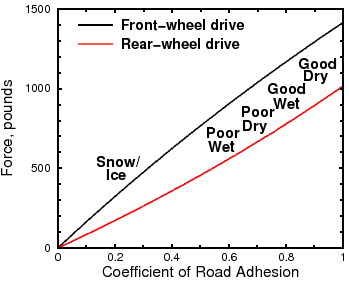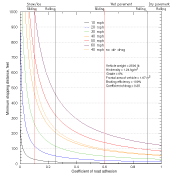How to Drive on Snow
 Things to think about while traveling over ice
Things to think about while traveling over ice
You might think that because I lived in suburban Washington, D.C. for twenty-six years that I know nothing about driving on snow. It's not true. I grew up in a mountainous area where deep snow--three to four feet--is common. People in that part of the country are often able to drive up a snow-covered hill, while inexperienced drivers from elsewhere get stuck. There's some useful information on the Internet about driving in snow. But there's also a lot of information that's basic and obvious, and some that's contradictory or just plain wrong. So here are a few helpful tips that I can share with my fellow Maryland snow wussies.
The worst conditions are when the temperature is around freezing, when the snow is fresh and the ice is covered with a thin layer of water. In places like North Dakota, even though it's much colder, it's actually easier to drive because the snow is so dry. Another dangerous time is when the temperature has suddenly dropped from above freezing to well below freezing, which causes black ice to form.
The central idea for driving on snow is the concept of "friction budget." Although car tires don't follow the physical laws of friction exactly, your car does depend on friction between its tires and the road to stay in control. Friction can be thought of as a force (remember the equation F=ma, force = mass × acceleration). But unlike an ordinary force, frictional acceleration is negative: friction slows you down. Also, for some substances, friction decreases with velocity. Any movement of your tires with respect to the road, in any direction, will exert a force on your tires that opposes the friction. When the net force becomes zero, you will skid--that is, your tire will accelerate, and in the worst-case scenario, the outside of your car could get all crinkly, and you will get a stubborn red stain all over your soft, rich Corinthian leather. Therefore, you need to think about your friction budget continuously while driving on ice and snow. There are two ways to balance your friction budget: by getting more of it and by spending less of it.
Increasing Your Friction
 Tractive force vs road adhesion for a typical 2500 pound car with
the engine in the front
Tractive force vs road adhesion for a typical 2500 pound car with
the engine in the front
When driving on packed snow or ice, your tires can only exert 28% as much force against the road as on dry pavement (see graph). If the engine is in the front, front-wheel drive is better in all conditions. If you were driving a VW Beetle, a Porche 911, or, heaven forbid, a Corvair, the two curves would be reversed. Once you begin to slide, your coefficient of road adhesion decreases even more, and so does the force your tires can exert.
- Snow tires This is fairly obvious. If you've got the same cheap all-weather tires that came with your car, or if your treads are less than 3/16 inch (0.48 cm) deep, do not drive! Buying an expensive new set of snow tires is the most effective way of preventing snow and cold weather known to man. The three months of extra winter sunshine and lack of snow caused by installing snow tires are well worth the expense. Your fellow snow wussies will thank you, too.
- Weight In the old days of rear-wheel drive, people used to put large steel weights (200 lbs or more) in the rear trunk, which push the car down and increase your friction. If you have four-wheel drive or rear-wheel drive, this is still good advice. If you don't have steel weights, you might be able to convince your mother-in-law to ride in the trunk. You can give her a walkie-talkie so she can still comment on your driving.
- All-wheel drive Many people think four-wheel drive makes it safe to drive on snow. It does help--as long as your tires don't slip. AWD doubles your friction when accelerating. But if you lose traction, AWD becomes little better than two-wheel drive. It will not prevent your wheels from spinning. Unless all four wheels are locked (which is typically possible only on off-road 4×4s and trucks), once a wheel loses traction, all the power goes to that wheel, making it spin while the other three do nothing. That's a subtle difference from what happens to a two-wheel drive car, where three wheels do nothing and the other one spins. Maybe it's not enough to call AWD a scam, but it's certainly widely misunderstood. Four-wheel drive also has no effect on your braking ability--which is one reason you always see so many SUVs and pickup trucks in the ditch.
As the graph at right shows, it takes 3.75 times as much distance to stop on snow or ice as on dry pavement. If you start to skid, that ratio increases to 8.5 (actually, 10 if you don't count the car's aerodynamic resistance). At 40 miles an hour, that means your minimum stopping distance, ignoring driver reaction time, goes from 4 car lengths to more than the length of a football field. The car's aerodynamic resistance actually becomes a measurable fraction of your total braking power when you're skidding on ice.
Decreasing Your Acceleration
 Driving up a snow-covered hill
Driving up a snow-covered hill
To avoid depleting your limited supply of friction, keep your car's kinetic energy, or more precisely, your acceleration, to a minimum. Acceleration, as used in physics, means any change in velocity or direction. Therefore, you should not try to change speed--either accelerating or braking--while going around a curve or driving on a hill. Take the situation of driving up a steep snow-covered road or driveway. You probably know that if you stop halfway up the hill, it's almost impossible to get started again. If there's traffic behind you, you can't go back downhill. You are stuck.
For example, near my house, there is a steep hill with an intersection and a stop sign at the bottom (see diagram at left). The road is never plowed or salted, so any snow eventually gets converted to ice by the traffic. Even snow tires and 4-wheel drive don't provide enough friction to accelerate and stay on the road at the same time. In the winter, any vehicle that tries to climb the hill from a dead stop--that is, from the stop sign--goes straight into the ditch. This maneuver (red arrow) is sometimes countered by those ubiquitous big guys in the brown jerseys, who can execute an effective defensive blocking action.
The only solution is to turn left, make a U-turn, and get a running start. If you do this, you can make the hill, if you have 4-wheel drive and snow tires. The only problem is avoiding all the tow trucks, the SUVs in the ditch, and the dead moose.
There are other tricks to be learned from the Wise Men of the Mountains and their magic 4×4s that can help you avoid getting stuck.
- Avoid acceleration, deceleration, and changes in direction. Not easy, perhaps, when you want to go to a specific place. But when driving up a snowy road, the worst thing you can do is to change speed or direction. Regardless of whether the change was voluntary or involuntary, your car must use some of its friction budget to make these changes. If it's used up, you start to spin. Get a running start, but then avoid turning or accelerating at all costs. While going up, give the vehicle just enough gas to avoid slowing down. If there's an obstacle on the hill, such as a tree limb, a moose, or another car sliding around, don't proceed until the obstacle is gone. If the obstacle forces you to change direction while you're climbing the hill, you're lost.
- Keep it in high gear. The lower torque will allow the wheels to change speed more rapidly and keep them from spinning. In low gear, it's also much harder to rock forward and back to get un-stuck. You don't need a lot of torque to drive on ice, and if your wheels start spinning while you're in low gear, your RPMs can become dangerously high before you realize it. (Going down a hill is another matter: low gear supposedly helps slow you down more smoothly than using your brakes. However, I am skeptical about this claim. Most likely, people got this idea from watching trucks. But trucks use low gear for an entirely different reason.)
- Avoid bumps. You might think if your driveway has clumps of snow or ridges of ice, it will increase your friction. Wrong. Hitting a clump of snow slows you down, changing your velocity. It also pushes you sideways just enough to create the sensation of losing control. This automatically makes you slow down or turn the wheel in an attempt to regain control. Physics tells us that there is greater contact between two smooth surfaces than two rough ones, leading to greater adhesive friction. So when shoveling your driveway, if you can't get through to the gravel or pavement, it's better to make it smooth than to leave bumps on it.
- Going downhill The maximum rate at which you can decelerate by braking is determined by the Earth's gravity (32.2 ft/s2). Of course, there are other ways to decelerate faster, but we try to avoid these. In mountainous areas, it can appear comical: cars are stacked up on the top of the hill like penguins, waiting for the first one to make the leap. But there are few things as frightening as sliding down a hill out of control. When at the top of the hill, you should slow almost to a stop, then brake very gently as you move downhill. Allow the vehicle to speed up a little rather than pressing hard on the brakes all the way down, which can cause skidding. If you do start to skid, take your foot off the brake and the gas, and keep the wheel straight until your wheels begin rolling. If the car changes direction, turn into the skid if possible.
- Driving at night Don't drive at night when it's snowing--the snow appears to be blowing toward your windshield, creating the illusion that you're stopped. It's a powerful illusion. Even though you can see the speedometer registering 50 miles per hour, it's tempting to get out and see why you're not moving. It should be obvious that this would be a big mistake.
- Other drivers When road conditions are bad, try to get behind the worst driver you can find. This is easy in some parts of the country. When they go flying off a cliff, it will give you advance warning of hazardous road conditions ahead.
Tire pressure
Does reducing your tire pressure make it easier to drive on snow and ice? The answer is "it depends." Reducing your tire pressure increases the area in contact with the snow. Friction is proportional to surface area times pressure, but pressure is the downward force per unit area. The two area terms cancel each other out, which means that the total friction is independent of the area of contact. Therefore, things that increase the area of contact, like using wide tires or reducing your tire pressure, will have no effect on friction. However, there are times you may want to do it anyway.
If you want to drive on the surface without sinking into the snow, lowering the tire pressure might help. For instance, if you live in Antarctica or some other place where the snow is several feet deep, sinking into the snow is not an option, so driving with low tire pressure, which spreads out your weight, may be a good idea. Narrow tires concentrate your weight into a smaller area, creating greater pressure, which tends to melt ice, making it more slippery. So if you're driving on solid ice, lowering your tire pressure will help a little.
Wider tires will also make your ride a little smoother. But this is not necessarily a good thing, because you get less information about the condition of the road. You may miss subtle clues like the fact that you're sliding on black ice, or that you've become airborne and are plummeting out of control toward a raging river. On the other hand, a smoother ride will make it easier to hear the screaming of your passengers as they realize they're headed for certain death.
Usually, you want your tires to cut through the snow, not ride on top of it. In this case, a fully inflated tire is better. Being narrower, it also pushes up a smaller mound of snow in front of it, making it less likely to get stuck. A properly inflated tire flexes less, making it easier to maintain control, and is less likely to be damaged. Your tire rims are also less likely to become dented if you hit a pothole than with an underinflated tire. Therefore, most experts recommend keeping your tires fully inflated, even on ice.
Traction
 Gravity lesson #1:
Frictional force between a weight and a surface
is proportional to the force pressing against the surface.
Gravity lesson #1:
Frictional force between a weight and a surface
is proportional to the force pressing against the surface.
We also have to take traction into account. In physics, traction is primarily caused by adhesive friction, which is described by Amontons' laws of friction (published in 1699), which state: (1) frictional force is proportional to the normal load (that is, the force perpendicular to the surface) and (2) friction is independent of area of contact. This means that, all other factors being equal, your friction will decrease by 1 - cos(45°) = 29.3% when going up a 45° slope. If you could drive vertically, your friction would be zero. In reality, it's not so simple, because the shape of the contact patch and the amount of traction can change depending on the dynamic load. For a real surface, increasing the area of contact does help a little, because the three-dimensional surface irregularities have a better chance to interlock. This interlocking gear-like effect is what most people think of when they think of traction.
When you're on a slope, the change in angle with respect to gravity not only reduces your friction, it also adds a new force that pushes your car forward or backward. This force is also subtracted from whatever frictional force remains. So if you're on a slope, gravity works against you in two different ways.
Finally, there is the heating effect. Over 90% of the energy associated with friction is converted to heat. The rest goes to elastic deformation, material loss, and noise. When your tires lose traction, all this heat energy is concentrated in one place. This heat melts the snow, which can then re-solidify in a state that resembles ice. The water also becomes a lubricant, which means you have to consider water viscosity, ice surface texture, and cooling rates. But heating your tires also makes them more pliable, which tends to increase your traction. These effects can become very complicated. Entire books have been written about the physics of car tires. Trying to solve all these equations in your head while you're plummeting down a snow-covered embankment is enough to give anyone a headache.
Of course, keep water, food, blankets, and a snow shovel in your car. Keep a cell phone in your car at all times. Then if you get stuck, you can order a pizza!
References
R. G. Bayer, Mechanical Wear Fundamentals and Testing, CRC Press

